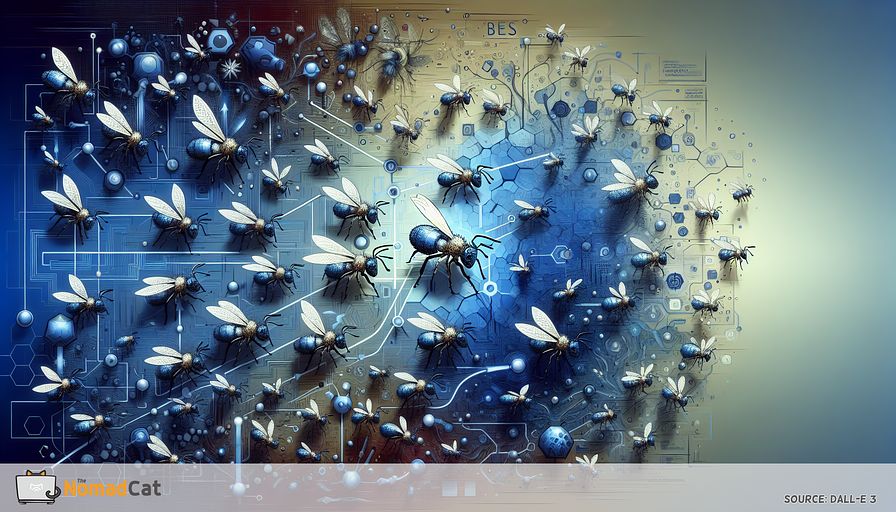Abstract:
Swarm robotics is at the forefront of transforming safety measures in hazardous environments. This technology, inspired by the natural world's collaborative efforts like those of ants and bees, harnesses the power of collective behavior to accomplish tasks too dangerous or complex for individual robots or humans. By deploying groups of robots that communicate and make decisions collectively, these systems can navigate and adapt to unpredictable conditions, offering groundbreaking solutions for disaster recovery, environmental monitoring, and hazardous material handling. The versatility and efficiency of swarm robotics not only enhance safety protocols but also significantly reduce the risk to human lives in critical operations. As we continue to develop and refine these technologies, the potential for swarm robotics to innovate safety strategies in various industries is immense, promising a future where collaborative robots play a crucial role in mitigating risks in dangerous settings.
Welcome to the World of Swarm Robotics
Imagine a world where the safety of our most hazardous environments is managed not by individuals but by an intelligent, collaborative fleet of robots. This isn't a scene from the latest sci-fi blockbuster but a glimpse into the revolutionary field of swarm robotics. Inspired by the natural world's most industrious workers, like the meticulously organized ants and the tirelessly efficient bees, swarm robotics is poised to redefine safety in environments that are dangerous for human beings. These small but mighty machines work together in a fascinating display of teamwork, taking cues from the collective behavior observed in nature to perform tasks with precision and resilience.
Swarm robotics operates on the principle that strength and intelligence lie in numbers and cooperation. Just as a swarm of bees adapts to new threats or a colony of ants efficiently finds food, these robotic swarms tackle complex problems by working together, making them incredibly versatile in facing the unpredictable. From navigating the aftermath of natural disasters to monitoring environmental hazards, these pint-sized powerhouses are not just about the technology but embody a bridge between biology and robotics, unleashing a wave of potential for safer, more efficient operations in places where humans tread carefully or not at all.
Let's lace up our digital boots and step into the world of swarm robotics. As we journey through this article, we'll explore how this technology is not just imitating nature but revolutionizing our approach to safety in some of the most challenging settings on (and possibly off) Earth. So, keep your antennas up and prepare to be amazed at how small inspirations from nature are leading to significant breakthroughs in technology and safety.
Understanding the Mechanics of Swarm Robotics
Peering under the hood of swarm robotics reveals a technical symphony of collective behavior and communication. It’s akin to understanding how a flash mob manages to coordinate such complex and synchronized moves, but instead of dancers, we have robots, and instead of dance moves, we’re orchestrating safety measures. The brilliance of swarm robotics lies in its ability to mirror the decentralized decision-making and adaptability seen in natural systems, such as ant colonies or flocks of birds. This section is your backstage pass to the mechanics powering these robotic marvels.
The Magic of Collective Behavior
At the heart of swarm robotics is the concept of collective behavior, the kind that doesn't rely on a central control system. Each robot in the swarm acts as both a follower and a leader, depending on the task at hand or the challenges it faces. Much like a group of hikers deciding on paths based on the obstacles they encounter, these robots make decisions on the fly. This decentralization allows the swarm to continue functioning even if several robots encounter issues, showcasing an incredible resilience and adaptability.
Communication: The Lifeline of the Swarm
For swarm robotics, communication is not just about passing messages; it's the lifeline that enables these robots to work as a cohesive unit. This can range from simple “I found something!” signals akin to what you might shout if you discovered a hidden path while hiking with friends, to complex data exchanges about environmental conditions or operational status. These communications channels enable the swarm to navigate and adapt to complex and unpredictable environments efficiently, often using wireless communication or sometimes even more innovative methods, like light signals or vibrations, to simulate the pheromone trails used by ants.
- Decision-Making: Emergent from simple rules followed by each member, leading to complex and adaptable problem-solving without centralized control.
- Adaptability: The capability to dynamically adjust strategies in response to environmental changes or internal disruptions.
- Environment Navigation: Mastery over traversing complex landscapes through collective exploration and data sharing.
Understanding the mechanics of swarm robotics offers a glimpse into a future where the safety and efficiency of operations in hazardous conditions are exponentially increased. These aren’t just groups of robots working together; they represent a shift in how we approach problem-solving and safety measures in unpredictable environments. Armed with the knowledge of their foundations, we're now better equipped to appreciate the wide spectrum of their applications and the challenges that lie ahead. And while we might not be using ant pheromones to communicate anytime soon, there’s certainly a lot we can learn about teamwork from our robotic counterparts.
Swarm Robotics in Disaster Recovery
In the aftermath of a disaster, time is of the essence, and the environments can often be too hazardous for human responders. Enter the role of swarm robotics, a shining beacon of hope in search and rescue missions amidst the rubble and chaos. These swarms, agile and undeterred by peril, offer a safer alternative to putting human lives at risk. Imagine a fleet of robots scouring through debris after an earthquake or navigating floodwaters to locate survivors - this is not the plot of a futurist movie but the real-world application of swarm robotics in disaster recovery.
The Vanguard of Search and Rescue Operations
Disaster zones are unpredictable, with risks lurking around every corner. Traditional search and rescue operations are not only slow but also fraught with danger. Swarm robotics transforms this grim picture by deploying a multitude of small robots, each capable of traversing dangerous terrains and communicating findings back to the rescue team. This collaborative effort significantly speeds up the search process, ensuring that help reaches those in need much faster. Thanks to their small size and agility, these robots can access areas that are otherwise unreachable or too risky for humans, from collapsed buildings to flooded urban areas.
The Benefits of Collaborative Robotic Intervention
The true power of swarm robotics in disaster recovery lies in their collective capabilities. Here are some standout benefits:
- Risk Reduction: By taking humans out of the immediate danger zone, swarm robotics minimizes the risk to human life during search and rescue operations.
- Enhanced Capabilities: Through their sheer numbers and the ability to share data and make decisions as a collective, swarm robots can cover larger areas more quickly and thoroughly than human teams or individual robots could.
- Adaptive Strategies: Much like adjusting plans on-the-go during a hiking trip when faced with unexpected obstacles, swarm robots can adapt their search patterns in real-time based on the changing conditions of the disaster scene.
As we integrate swarm robotics into disaster recovery strategies, we’re not just optimizing the efficiency of search and rescue operations. We're also paving the way for a future where the safety of both survivors and rescuers is significantly enhanced. This collaborative approach, inspired by the natural world, doesn’t just add a layer of safety; it revolutionizes the entirety of disaster response. In the shadow of calamity, these robotic teams shine a light on the incredible potential for technological innovation to preserve and protect life.
Applications in Environmental Monitoring and Hazardous Material Handling
The versatility of swarm robotics stretches far beyond disaster recovery, casting a wide net over the realms of environmental monitoring and hazardous material handling. In these domains, swarm robotics not only steps in to mitigate risks but performs with a flair for efficiency and safety that single robots or human teams might envy. Let's peel back the layers of how these tiny technological troopers are making big waves in keeping us and the environment safe.
Environmental Monitoring: The Eco-Warriors
In the quest for environmental preservation, swarm robotics acts as our boots on the ground (or, more accurately, our wheels, legs, and propellers in diverse terrains). These robotic swarms serve as our eyes and ears across vast expanses, from dense forests tracking illegal logging activities to the depths of the ocean monitoring water quality. The strength of swarm robotics in environmental monitoring lies in their capability to cover large areas, collecting data and offering insights into environmental changes with a granularity and speed impossible for humans to achieve alone.
Consider the scenario where individual robots are deployed to monitor air pollution levels across a sprawling city; a task daunting in both scope and complexity for human teams. Swarm robotics transforms this challenge into a finely choreographed dance of data collection and analysis, with robots sharing real-time updates, ensuring a comprehensive overview of the city's air quality. This level of detailed monitoring allows for swift interventions, perhaps even before humans feel the effects of pollution, showcasing a proactive approach to environmental stewardship.
Hazardous Material Handling: The Risk Avengers
The handling of hazardous materials presents a particularly perilous puzzle, one that swarm robotics approaches with the deftness of a seasoned bomb disposal team, but with less drama and certainly less potential for human harm. These robotic teams venture where humans tread lightly (or not at all), managing tasks like cleaning up toxic spills, managing nuclear waste, or handling biohazard materials. The use of swarm robotics in these scenarios isn’t just advantageous; it’s a game-changer, dramatically reducing the risk to human health and life.
- Precision and Efficiency: Swarm robots can perform delicate operations, such as segregating toxic waste or neutralizing chemical spills, with precision, reducing the chance of errors that might exacerbate an already dangerous situation.
- Safety First: By delegating hazardous material handling to robots, we minimize human exposure to dangerous substances, ensuring that safety protocols aren't just followed but amplified.
- Scalability: Whether the task at hand involves a minor cleanup or a major hazardous waste management operation, swarm robotics can scale to meet the challenge, adjusting their numbers and strategies on the fly.
The deployment of swarm robotics in environmental monitoring and hazardous material handling underscores a pivotal shift toward prioritizing safety and efficiency in some of the most critical tasks faced by our society today. As these robotic teams venture into territories laden with risks, they not only protect human lives but also promise a future where environmental stewardship and safety in industrial operations are not just ideals but realities. With each successful mission, swarm robotics inches us closer to a world where the balance between technological advancement and environmental conservancy is not just achievable but sustainable.
Challenges and Future Development
Embarking on the journey of integrating swarm robotics into safety protocols and operations across various industries is akin to planning a moon landing. It's exciting, fraught with unknowns, and not without a healthy dose of challenges that might make even the most fervent tech enthusiast pause for thought. Technical glitches, ethical dilemmas, and logistical labyrinth—are just the tip of the iceberg. However, the future is bright (or at least, brilliantly automated), with ongoing research and technological innovation promising to navigate these choppy waters.
Navigating Choppy Waters: The Challenges Ahead
Before our swarm robotic fleets can take full command of disaster recovery, environmental monitoring, and hazardous material handling, there are a few hurdles to clear. On the technical front, creating robust, fault-tolerant systems that can operate in dynamic and unpredictable environments is no small feat. Imagine trying to coordinate a dance troupe where each member learns the steps on the fly, in a room that keeps changing shape. That's the level of complexity involved in ensuring effective communication and decision-making among swarm robots.
Ethically, we're stepping into a minefield of considerations, from data privacy to ensuring that the deployment of these technologies doesn't inadvertently put human jobs at risk. There's also the challenge of ensuring these systems can't be co-opted for unintended or nefarious purposes—a real-life game of "keep away" against potential cyber threats.
Logistically, the scalability of swarm robotics poses its own set of questions. Deploying a handful of these machines might be straightforward, but coordinating thousands or even millions requires logistical sorcery on a grand scale. Infrastructure, energy requirements, and maintenance are just a few of the considerations that could make or break the widespread adoption of swarm robotics.
The Dawn of Tomorrow: Overcoming Obstacles with Innovation
- Technological Advances: Continuous improvements in computing power, artificial intelligence, and communication technologies are paving the way for more sophisticated and resilient swarm robotic systems.
- Collaborative Research: The academia and industry tango is crucial for addressing ethical and logistical challenges, ensuring that the development of swarm robotics aligns with societal norms and practical feasibility.
- Regulatory Frameworks: Developing clear, comprehensive guidelines for the deployment and use of swarm robotics will be key to navigating ethical and logistical minefields with finesse.
As we venture forward, the allure of transforming safety protocols and operations with swarm robotics remains undiminished. With every technical hurdle cleared, ethical question answered, and logistical puzzle solved, we edge closer to a future where the prowess of swarm robotics is fully unleashed. Laugh in the face of challenges, for the swarm is coming, and it's bringing a safer, more efficient world with it.
The Future of Safety with Swarm Robotics
The journey through the revolutionary domain of swarm robotics brings us to the brink of a new era in managing safety within hazardous environments. We've seen how these tiny yet mighty machines, drawing inspiration from the collaborative genius of nature, are not just poised to assist but to transform how we tackle danger. From the meticulous orchestration of disaster recovery operations to the vigilant monitoring of environmental health and the cautious handling of hazardous materials, swarm robotics presents a beacon of hope and ingenuity.
As we stand at this juncture, looking towards the horizon, the promise held by swarming collaborators in robotics is clear. These are not mere tools but partners in our quest to safeguard human lives against the precariousness of extreme conditions. The potential for these robotic swarms to venture where humans fear to tread—to execute tasks with a precision and resilience unmatched by human efforts alone—is nothing short of revolutionary. Imagine a future where no human need risk life for rescue or exploration in danger zones; where swarms of robots stand at the ready, guardians of our safety and stewards of our environment.
The narrative of swarm robotics is still being written, each development chapter adding layers of complexity and capability. Yet, amid the technical jargon and the systemic intricacies, a simple truth resonates: collaboration, whether in nature or technology, holds the key to solving our greatest challenges. As these swarms of robotic marvels continue to evolve, so too does our capacity to protect and preserve life in its most vulnerable moments. The future of safety, it seems, is not just about facing hazards—it's about outsmarting them, together.














